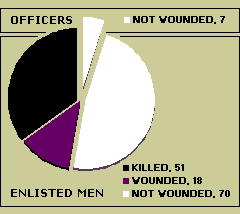
Colhoun’s casualties off Guadalcanal, 30 August 1942.

Source: Bureau of Personnel casualty report, NARA.
When the expansion of World War II in Europe and growing tension with Japan required enlarging the active fleet, Colhoun was taken to the Norfolk Navy Yard in June 1940 and converted to a high-speed transport. With the new hull number APD-2, she recommissioned in December 1940 for operations and training in the Atlantic and Caribbean in connection with the development of an enhanced amphibious warfare capability.
Colhoun arrived in the south Pacific in July 1942 and helped land US Marines on Tulagi on 7–8 August, at the opening of the long and bloody Guadalcanal Campaign. She continued on transport and patrol service during the first weeks of that operation. On 30 August 1942, while off Guadalcanal, she was targeted by Japanese bombers. Hit several times, USS Colhoun soon sank off Lunga Point with the loss of 51 crewmembers.
Colhoun earned two service stars for operations in World War II.
Sources: Clark, Curt, The Famed Green Dragons; Naval History & Heritage Command including Dictionary of American Naval Fighting Ships.